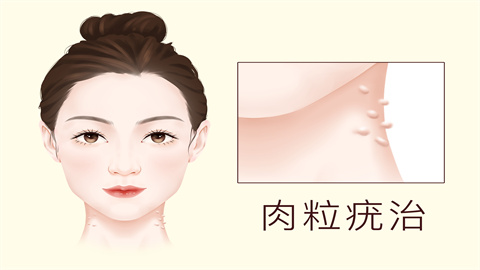What does it mean to have small flesh growths on the body?
Generally, small flesh-colored skin growths may be caused by skin aging, friction irritation, eczema, filiform warts, or molluscum contagiosum. It is recommended to seek timely medical advice and undergo treatment under a physician's guidance. Detailed explanations are as follows:

1. Skin Aging
With age, the skin's metabolism gradually slows down, collagen is lost, and the function of elastic fibers declines, weakening the skin's ability to self-repair and renew. This may lead to localized skin tissue proliferation and the formation of small flesh-colored growths. It is recommended to maintain skin hydration by using mild moisturizing skincare products daily, and to protect against sun exposure to reduce UV damage and delay skin aging.
2. Friction Irritation
Long-term friction from clothing or accessories, such as tight clothing repeatedly rubbing against the armpits or neck, or tight necklaces irritating the skin on the neck, can cause thickening of the skin's keratin layer and tissue proliferation, resulting in small flesh-colored growths. In daily life, choose loose, soft clothing, avoid wearing tight accessories, and reduce skin friction.
4. Eczema
Eczema may be related to internal factors such as endocrine and metabolic changes, psychological factors, and external factors such as food allergies or contact allergens. At certain stages of eczema development, the skin may develop papules and vesicular papules. After scratching, these may merge into肉-like skin rashes, possibly accompanied by symptoms such as erythema, exudation, and desquamation. Follow medical advice to use medications such as mometasone furoate cream, halometasone cream, or tacrolimus ointment for treatment.
3. Filiform Warts
Filiform warts are caused by infection with the human papillomavirus (HPV), primarily low-risk HPV types. After the virus invades epidermal cells, it replicates extensively within the cells, stimulating abnormal proliferation and differentiation of epidermal cells, leading to the formation of thread-like small flesh-colored growths, commonly occurring on the neck, eyelids, and other areas. Generally, there are no other obvious accompanying symptoms, although some individuals may experience mild itching. Patients may use tretinoin cream, fluorouracil cream, imiquimod cream, and other medications as advised by a physician.
5. Molluscum Contagiosum
Molluscum contagiosum is caused by the molluscum contagiosum virus and is primarily transmitted through direct contact, although it can also spread indirectly through shared towels or clothing. After infecting the skin, the virus proliferates within epidermal cells, causing cellular degeneration and necrosis, forming waxy, dome-shaped papules—these small flesh-colored growths. Patients may also experience mild itching or ulceration. Treatment options include salicylic acid ointment, cidofovir gel, tazarotene gel, and other medications as directed by a physician.
In daily life, maintain good personal hygiene by bathing regularly and changing clothes frequently. Eat a balanced diet and avoid excessive consumption of spicy, greasy, or irritating foods. Strengthen your immune system through moderate exercise and ensure adequate sleep.







